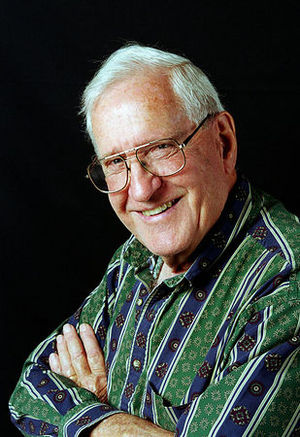Harold Agnew: Difference between revisions
No edit summary |
m (Text replace - "[[Category:Scientific tools and discoveries" to "[[Category:Engineering fundamentals") |
||
| (5 intermediate revisions by 2 users not shown) | |||
| Line 1: | Line 1: | ||
== | == Biography == | ||
[[Image:Harold agnew.jpg|thumb| | <p>[[Image:Harold agnew.jpg|thumb|right|Harold Agnew]] </p> | ||
Harold Agnew was born in Denver, Colorado in 1921. After receiving his undergraduate degree in chemistry from the University of Denver in 1942, he joined [[Enrico Fermi|Enrico Fermi’s]] research group at the University of Chicago and witnessed the first controlled nuclear chain reaction in December 1942. | <p>Harold Agnew was born in Denver, Colorado in 1921. After receiving his undergraduate degree in chemistry from the University of Denver in 1942, he joined [[Enrico Fermi|Enrico Fermi’s]] research group at the University of Chicago and witnessed the first controlled nuclear chain reaction in December 1942. </p> | ||
Agnew worked on the [[Manhattan Project|Manhattan Project]] at Los Alamos from 1943 to 1945. He flew as a scientific observer during the mission to Hiroshima on 6 August 1945 to measure the yield of the atomic bomb explosion. After completing his graduate degree under Enrico Fermi at the University of Chicago in 1949, Agnew returned to Los Alamos, and became the laboratory’s Weapons Division leader from 1964 to 1970. | <p>Agnew worked on the [[Manhattan Project|Manhattan Project]] at Los Alamos from 1943 to 1945. He flew as a scientific observer during the mission to Hiroshima on 6 August 1945 to measure the yield of the atomic bomb explosion. After completing his graduate degree under Enrico Fermi at the University of Chicago in 1949, Agnew returned to Los Alamos, and became the laboratory’s Weapons Division leader from 1964 to 1970. </p> | ||
Agnew retired from Los Alamos in 1979, and has since served as a scientific advisor to NATO | <p>Agnew retired from Los Alamos in 1979, and has since served as a scientific advisor to NATO, Alsos Digital Library for Nuclear Issues (1961-1964), chaired the General Advisory Committee of the Arms Control and Disarmament Agency (1974-1978), and served as White House science councilor (1982-1989). </p> | ||
<p>Agnew is the recipient of the E.O. Lawrence Award (1966) and the Department of Energy Enrico Fermi Award (1987). Along with Hans Bethe, Agnew was the first to receive the Los Alamos National Laboratory Medal. Agnew currently teaches at the University of California, San Diego. </p> | |||
== Larson Collection Interview == | |||
< | <youtube>mfPf_rs2EZY</youtube> | ||
[[Category: | [[Category:Nuclear and plasma sciences|Agnew]] [[Category:Fusion reactors|Agnew]] [[Category:Engineering fundamentals|Agnew]] [[Category:Scientific disciplines|Agnew]] [[Category:Chemistry|Agnew]] [[Category:News|Agnew]] | ||
Revision as of 16:32, 22 July 2014
Biography
Harold Agnew was born in Denver, Colorado in 1921. After receiving his undergraduate degree in chemistry from the University of Denver in 1942, he joined Enrico Fermi’s research group at the University of Chicago and witnessed the first controlled nuclear chain reaction in December 1942.
Agnew worked on the Manhattan Project at Los Alamos from 1943 to 1945. He flew as a scientific observer during the mission to Hiroshima on 6 August 1945 to measure the yield of the atomic bomb explosion. After completing his graduate degree under Enrico Fermi at the University of Chicago in 1949, Agnew returned to Los Alamos, and became the laboratory’s Weapons Division leader from 1964 to 1970.
Agnew retired from Los Alamos in 1979, and has since served as a scientific advisor to NATO, Alsos Digital Library for Nuclear Issues (1961-1964), chaired the General Advisory Committee of the Arms Control and Disarmament Agency (1974-1978), and served as White House science councilor (1982-1989).
Agnew is the recipient of the E.O. Lawrence Award (1966) and the Department of Energy Enrico Fermi Award (1987). Along with Hans Bethe, Agnew was the first to receive the Los Alamos National Laboratory Medal. Agnew currently teaches at the University of California, San Diego.
Larson Collection Interview
<youtube>mfPf_rs2EZY</youtube>
